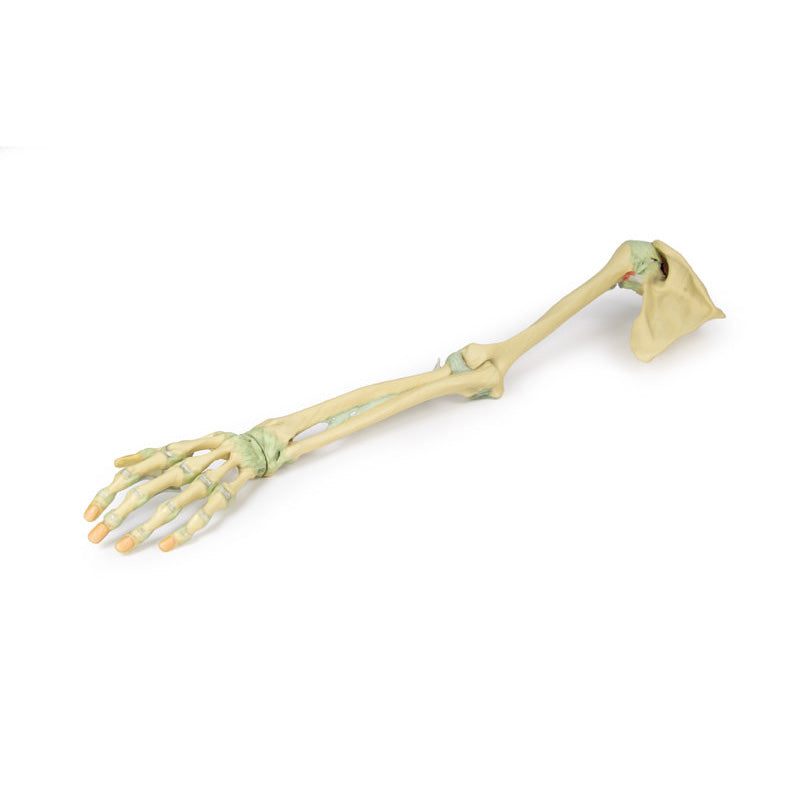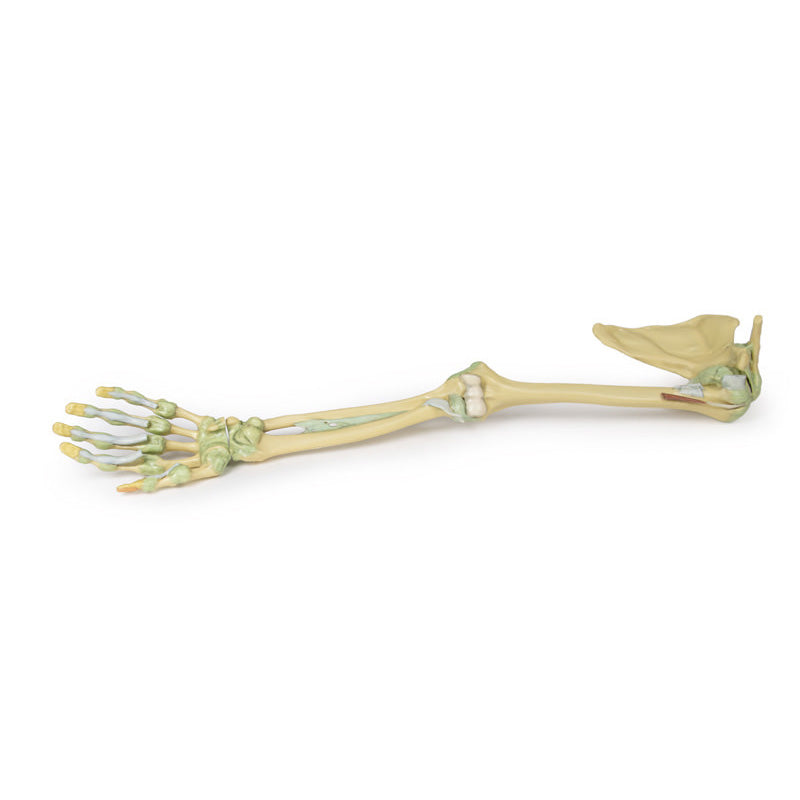Your shopping cart is empty.
3D Printed Upper Limb Skeleton and Ligaments
A small portion of the supraspinatus muscle belly and tendon are preserved to demonstrate the passage of the muscle deep to the coracoacromial ligament, which is a very clinically relevant area of anatomy. The tendon of the subscapularis muscle has been reflected slightly to expose the anterior aspect of the glenohumeral joint capsule, and the tendon of the long head of triceps brachii, teres major, and latissimus dorsi are preserved surrounding the capsule and proximal humerus.
The tendon of the long head of biceps brachii is visible within the intertubercular groove, and exposed within the superior glenohumeral joint capsule as it approaches the supraglenoid tubercle.
The capsule of the elbow joint has been dissected to expose the articular surfaces of the distal humerus, proximal radius and proximal ulna. Both the ulnar and radial collateral ligaments are preserved, as is the annular ligament of the radius. Just distal to the joint capsule, the tendinous insertion of the biceps brachii is preserved as it inserts into the dorsal aspect of radial tuberosity.
Distal to the interosseous membrane, the palmar and dorsal ligaments of the wrist joint are preserved (including the radial and ulnar collateral ligaments, palmar and dorsal radiocarpal and ulnocarpal ligaments, pisohamate, pisometacarpal, radiate capitate, palmar and dorsal carpometacarpal ligaments). In the hand, the metacarpophalangeal and interphalangeal joint capsules with collateral ligaments are preserved for all digits, including the palmar ligaments (volar plates); the capsules are open dorsally to appreciate the articulations between elements. The terminal portions of the flexor digitorum superficialis and profundus tendons are retained to show their insertions into the bases of the intermediate and distal phalanges, as is the flexor pollicis longus tendon inserting to the base of the terminal phalanx of the first digit.
Download Handling Guidelines for 3D Printed Models
GTSimulators by Global Technologies
Erler Zimmer Authorized Dealer

9.0 lb
🎄 HOLIDAY SAVINGS - Ends Dec 31 🎄
Discount has been automatically applied for this item.
3D Printed Upper Limb Skeleton and Ligaments
Item # MP1520
$1,689.00
$1,877.00
You save $188.00
Need an estimate?
Click Add To Quote

Features & Specifications
-
by
A trusted GT partner -
FREE Shipping
U.S. Contiguous States Only -
3D Printed Model
from a real specimen -
Gov't pricing
Available upon request
Frequently Bought Together
3D Printed Upper Limb Skeleton and Ligaments
This 3D printed specimen presents the entire upper limb skeleton and ligaments from the pectoral girdle to the hand. In the pectoral girdle, the ligaments spanning the clavicle and scapula (acromioclavicular, coracoclavicular, coracoacromial) as well as the superior transverse scapular ligament spanning the suprascapular notch, are visible.A small portion of the supraspinatus muscle belly and tendon are preserved to demonstrate the passage of the muscle deep to the coracoacromial ligament, which is a very clinically relevant area of anatomy. The tendon of the subscapularis muscle has been reflected slightly to expose the anterior aspect of the glenohumeral joint capsule, and the tendon of the long head of triceps brachii, teres major, and latissimus dorsi are preserved surrounding the capsule and proximal humerus.
The tendon of the long head of biceps brachii is visible within the intertubercular groove, and exposed within the superior glenohumeral joint capsule as it approaches the supraglenoid tubercle.
The capsule of the elbow joint has been dissected to expose the articular surfaces of the distal humerus, proximal radius and proximal ulna. Both the ulnar and radial collateral ligaments are preserved, as is the annular ligament of the radius. Just distal to the joint capsule, the tendinous insertion of the biceps brachii is preserved as it inserts into the dorsal aspect of radial tuberosity.
Distal to the interosseous membrane, the palmar and dorsal ligaments of the wrist joint are preserved (including the radial and ulnar collateral ligaments, palmar and dorsal radiocarpal and ulnocarpal ligaments, pisohamate, pisometacarpal, radiate capitate, palmar and dorsal carpometacarpal ligaments). In the hand, the metacarpophalangeal and interphalangeal joint capsules with collateral ligaments are preserved for all digits, including the palmar ligaments (volar plates); the capsules are open dorsally to appreciate the articulations between elements. The terminal portions of the flexor digitorum superficialis and profundus tendons are retained to show their insertions into the bases of the intermediate and distal phalanges, as is the flexor pollicis longus tendon inserting to the base of the terminal phalanx of the first digit.
Download Handling Guidelines for 3D Printed Models
GTSimulators by Global Technologies
Erler Zimmer Authorized Dealer
These items normal warranty are two years, however the warranty doesn’t cover “wear and tear”. The manufacturer does have 100% quality control on these models.
The models are very detailed and delicate. With normal production machines you cannot realize such details like shown in these models.
The printer used is a color-plastic printer. This is the most suitable printer for these models.
The plastic material is already the best and most suitable material for these prints. (The other option would be a kind of gypsum, but this is way more fragile. You even cannot get them out of the printer without breaking them).The huge advantage of the prints is that they are very realistic as the data is coming from real human specimen. Nothing is shaped or stylized.
The users have to handle these prints with utmost care. They are not made for touching or bending any thin nerves, arteries, vessels etc. The 3D printed models should sit on a table and just rotated at the table.
The models are very detailed and delicate. With normal production machines you cannot realize such details like shown in these models.
The printer used is a color-plastic printer. This is the most suitable printer for these models.
The plastic material is already the best and most suitable material for these prints. (The other option would be a kind of gypsum, but this is way more fragile. You even cannot get them out of the printer without breaking them).The huge advantage of the prints is that they are very realistic as the data is coming from real human specimen. Nothing is shaped or stylized.
The users have to handle these prints with utmost care. They are not made for touching or bending any thin nerves, arteries, vessels etc. The 3D printed models should sit on a table and just rotated at the table.

by — Item # MP1520
3D Printed Upper Limb Skeleton and Ligaments
$1,689.00
$1,877.00
Add to Cart
Add to Quote






































































